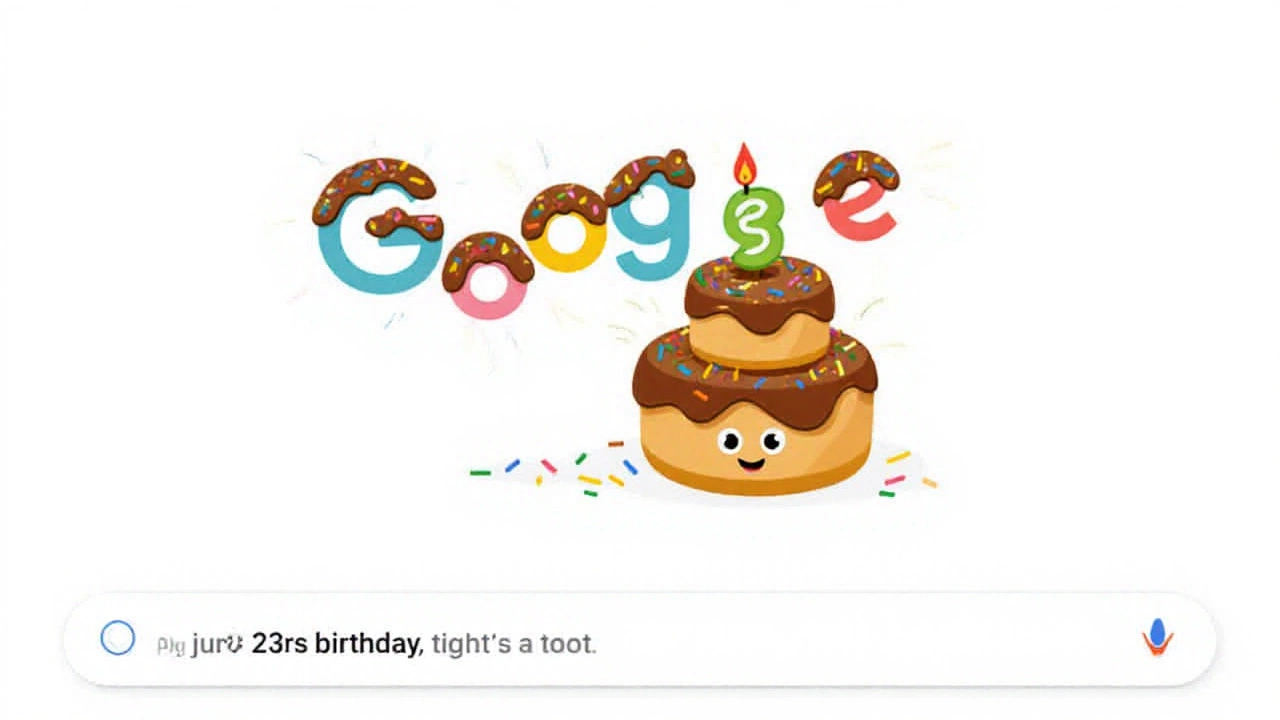The chocolate‑covered doodle that turned heads
When you opened the Google homepage on September 27, 2021, you were greeted by a slice of birthday cake that seemed to jump off the screen. The animated doodle featured a rich chocolate cake, glossy frosting, and rainbow‑colored sprinkles that danced around the number Google 23rd birthday. A single candle replaced the familiar "L" in the logo, flickering as if it were waiting for a wish.
What made the doodle more than just a pretty picture was the subtle motion built into it. The cake lifted its top layer, bowed politely, and then settled back down, as if thanking every visitor for being part of the celebration. That kind of interactivity is classic Google – turning a routine search experience into a moment of surprise. For a few seconds, the search engine felt less like a tool and more like a friend sharing a slice of cake.
Google didn’t just slap a static image on the page. The animation looped smoothly, and the candle’s flame wavered in sync with the user’s scrolling. If you hovered over the "23" on top of the cake, the numbers would glow, adding a playful layer of engagement. It’s the kind of detail that makes you pause, smile, and maybe even click that extra search result out of pure curiosity.
Why September 27 matters more than the official founding date
Most people think Google’s birthday is September 4, 1998 – the day the company was legally incorporated. But the founders, Larry Page and Sergey Brin, chose September 27 as the day to celebrate. Why? That was the day the search engine announced it had indexed a record‑breaking number of web pages. In simple terms, it marked the moment Google went from a cool university project to a genuine force on the web.
The story starts in a cramped Stanford dorm room where two computer‑science grad students built a prototype that ranked pages by the number of links pointing to them. That novel approach quickly outperformed existing search tools, and the milestone of indexing millions of pages gave the duo a reason to raise a toast. By honoring September 27, Google reminds its users that the company’s identity is tied to breakthrough moments, not just paperwork.
Fast forward 23 years, and the company is headed by Sundar Pichai, an Indian‑origin CEO who took the reins in 2015. Under his leadership, Google has expanded far beyond search – into cloud services, AI research, hardware, and even health technology. Yet the doodle’s simple cake design underscores a timeless truth: at its core, Google still wants to make information accessible, just like a good slice of cake makes a party better.
The birthday celebration didn’t stop at the homepage. Google rolled out special deals and discounts across several European markets. From free premium trials on YouTube Music to limited‑time offers on Google Nest devices, the promotions felt like party favors for a global audience. Users in France, Germany, and the Netherlands reported receiving discount codes via email, all stamped with a tiny cake icon that echoed the doodle’s design.
Meanwhile, the company’s social‑media teams joined the fun. Google India’s Twitter account posted a cheeky note: "Two computer science students just so happened to build a search engine in their dorm rooms in 1998. Today, we're blowing out 23 candles in our room." The tweet was accompanied by a short animation of the doodle, quickly racking up likes and retweets. Fans replied with memes, GIFs, and even requests for a virtual slice of the cake – a testament to how strong the brand’s emotional connection has become.
Google’s doodle tradition began in 1998 when the homepage displayed a simple “G” in a different color to mark the launch of the first online Doodles, or “the special license plate” as they were called internally. Over the years the company has used the platform to celebrate everything from holidays to scientific achievements. The chocolate cake doodle is just the latest in a long line of creative homages, but it stands out because it tied together a milestone birthday, an iconic visual, and a user‑friendly animation.
What makes these doodles matter? They’re more than decorative flourishes. They demonstrate Google’s willingness to experiment with web technology in real time. The animated cake used HTML5 canvas, CSS3 transitions, and JavaScript to create a lightweight, cross‑browser experience. It runs smoothly on smartphones, tablets, and desktops, showing how the company can push artistic ideas without sacrificing performance.
Beyond the tech, there’s a cultural angle. Birthdays are universally understood, and a chocolate cake is a near‑global symbol of celebration. By choosing that motif, Google ensured the doodle resonated with users in Delhi, São Paulo, Nairobi, and Reykjavik alike. The rainbow sprinkles added a dash of modern flair, hinting at the company’s focus on diversity and inclusion.
Looking back, the 23‑year journey feels both rapid and inevitable. From a pair of dorm‑room PCs to a conglomerate that invests billions in quantum computing, the transformation is staggering. Yet the simple pleasure of watching a cake bow on the world’s most visited homepage reminds us that Google’s biggest strength is still its ability to make complex things feel accessible.
As the day turned into night and the candle’s flame finally flickered out, users across the globe were left with a fleeting but memorable moment. The doodle may have been gone the next day, but its impact lingers – a reminder that even tech giants can celebrate with a slice of chocolate and a sprinkle of joy.
